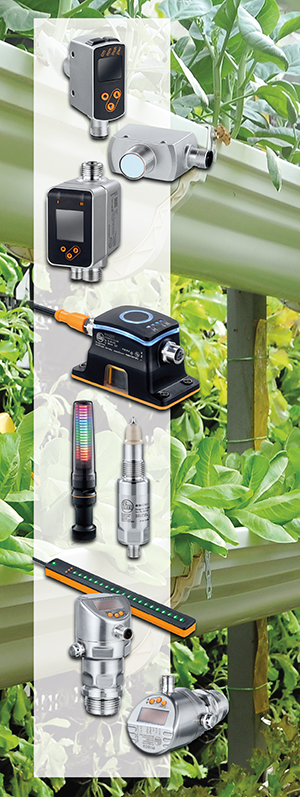
Feeding the world’s population despite limited resources is a task that requires ever more arable land and fresh water. Highly automated vertical farms could be the future of agriculture.

The food is grown indoors so that the yield is free from pests, pathogens or bad weather. At the same time, this type of cultivation requires 95% less water, and fertilisers are used with exactly the right dose. There is no need for pesticides and other polluting substances in such systems. Another advantage of this type of cultivation is that vertical farms can be built in the direct vicinity of cities, which saves logistics costs and reduces CO2 emissions.
The challenge
For the plant growth to be accurately controlled and in order to achieve a high degree of automation, a large number of variables must be measured in an indoor farm. On the basis of these measured values, the system can then be optimised to maximise crop yield.
Modern vertical farms require a system combination of hardware, automation, intelligent controllers and sensors. The process control and the data acquisition are becoming increasingly complex. A conventional system design requires a considerable amount of programming and integration.
Each indoor farm has hundreds of I/O signals on its individual vertically stacked layers, which used to be routed back separately to the controller in the past. Accordingly, maintenance work, troubleshooting and the replacement of sensors were very time-consuming. Better and smarter solutions were required for the new projects.
The solution
A variety of different process sensors are used for indoor farms. ifm provides sensors for monitoring temperature, humidity, CO2 levels and light intensity. These sensors help maintain optimal growing conditions and allow farmers to make necessary adjustments to ensure the health and growth of plants.
Flow sensors from ifm can be used to measure and monitor water flow rates, ensuring precise irrigation and nutrient delivery to plants. This helps in maintaining the right moisture levels and nutrient balance in the growing environment.
ifm’s level sensors can be used to monitor water levels in tanks, reservoirs and irrigation systems. They ensure that water levels are maintained within the desired range, preventing over- or under-watering of plants.
Pressure sensors are useful for monitoring and controlling irrigation systems, ensuring that water pressure is appropriate for efficient water distribution throughout the growing area.
ifm also offers light sensors that can measure and monitor light intensity. These sensors help in optimising artificial lighting systems used in indoor farming, ensuring that plants receive the right amount and quality of light for photosynthesis and growth.
ifm provides control systems and automation solutions that enable precise control over various aspects of indoor farming, including irrigation, nutrient dosing, lighting cycles and climate control. These systems allow for efficient and automated management of farming processes.
The results are:
• All relevant measured values for the indoor farm can be easily monitored, ensuring high product quality and less rejected produce.
• Efficient connection of the sensors via IO-Link.
• Commissioning becomes faster and more efficient.
• Systems are scalable thanks to technological support from ifm.
Communication and connectivity solutions
ifm offers products for data acquisition, communication and connectivity, allowing farmers to collect and analyse data from sensors, and remotely monitor and control their indoor farming operations. Connecting all sensors via IO-Link field modules reduces the complexity of process control and makes more data available from each sensor, thus reducing the overall need for sensors. Recipe changes and design adaptations due to ongoing innovations are easy to implement using digital communication. The entire setup process from physical wiring to integration and programming has thus become much more efficient.
With the help of IO-Link technology, customers are now able to standardise their systems and individual modules so that vertical farms can be scaled very easily. Hence, future projects can be implemented much more easily, while also accelerating setup.
Customers see ifm as a technology partner who is able to help with improving all of their applications. What is more, sensors from ifm can be used in the harvesting process, which is also automated: image processing, position sensors and RFID are just a few examples – and here too, ifm can of course provide the best possible support.
ifm’s family-run group of companies develops innovative Industry 4.0 solutions and corresponding software and cloud products to make existing business processes digitally usable and to offer new, holistic control options for sustainable efficiency and cost optimisation. It has subsidiaries and production sites in more than 70 countries worldwide, with a sales and service team of over 1450 employees. Its large product portfolio includes position and process sensors, sensors for motion control, and safety technology. Furthermore ifm offers products for industrial imaging and communication, and systems for identification and mobile machines.
The company has made sustainable value creation an essential prerequisite for business success. Its products, services and software help to protect the environment worldwide and reduce CO2 emissions, energy and material use. For ifm, climate-friendly action begins on its own doorstep and is not limited to energy efficiency or the use of renewable energy sources. The construction of its first green factory in Romania marks a milestone in eco-friendly and climate-neutral manufacturing, and serves as a blueprint for future construction projects, bringing the company one step closer to its goal of becoming climate-neutral by 2030.
| Tel: | +27 12 450 0400 |
| Email: | [email protected] |
| www: | www.ifm.com/za |
| Articles: | More information and articles about ifm - South Africa |

© Technews Publishing (Pty) Ltd | All Rights Reserved